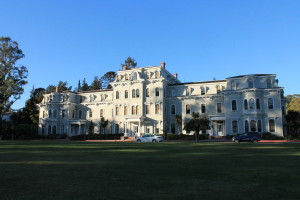
Mills College welcomed Chris Sollars as the new assistant professor of studio art in the Fall of 2015. Sollars’ work is described on his website as “the reclamation and subversion of public space through interventions and performance.” Documented through photography and video, his work is then turned into mixed media installations.
Sollars studied sculpture for his undergrad at Rhode Island School of Design and grad at Bard College, and he currently directs 667Shotwell, a studio space in his home that he established in 2001. The space is currently used for an ongoing series of exhibitions where artists create installations and actions in the Shotwell house.
How did you begin making art?
I think it is always just tapping into the ways I work and how my brain works. I think spatially in certain ways. I always liked to draw. Within my social conditioning, there was always a freedom to do and explore what I wanted to do versus there being a certain path for me. The public school system in Indianapolis in the 80s had a montessori system, which is tactile learning and working spatially, and I think that always had a giant impact on me. It wasn’t until I was in college that I had that level of interest in wanting to learn again. I wanted to see as much and experience as much as possible. I would just spend a lot of time making tons of different things all the time. I realized that I really enjoyed making and building things, which is what led me into sculpture.
From beards and mustaches as sculptures, to documenting people walking in the path of water, your work varies a lot. What is the common theme that runs through your work?
The way that I approach things is similar — there might be a public action that is documented with photographs or video, and there might be a sculpture involved and all those things can go together. Often it’s like I am directing and orchestrating things and my role changes depending on the scale and the amount of people involved.
You describe your work as public art, can you explain what that means in the context of your work?
I always considered doing things out in the public as a way in which you don’t have to pay for an experience, and you don’t have to go to a certain location. I like things where you might come across them, where you are not waiting for something to happen — maybe it happens and you just come across it. I like that moment of discovery. I might do public things that are not outside and might be indoors. Like people waxing mustaches as a weird, crazy idea of what a sculpture can be. Or putting people in the path of water and have them be the flow of water.
Do you think more artists are creating public art? Why?
I think that has increased exponentially since I was a student. And that is happening because of opportunities, including that a lot of things maybe an art market can not support. And I think it is also people in opposition to a commercial endeavor. There are more and more artists that are very interested in public experiences that challenge themselves as much as the viewers. For me it really goes back to what things are private information and what things are public information, which really goes back to the way that I grew up.

Where do you find inspiration for your art?
I think we all have private moments and also very public moments and social movements and that became part of my working mode. I just will sit sometimes and I will write down the ideas that are coming. I get those sitting thinking moments and when they come, I just let them come. That generates pieces or sometimes seeing things will generate a piece. Maybe I’ll read something and it’s like “yeah, totally, I need to make some work about that.”
You spent your summer at an artist residency program at the Recology Center in San Francisco. What were you working on?
The residency is four months and you get a studio and full access to what people dump. So you get to go dig through, not household trash, but what people dump when they have to clean out someone’s home, or when they are demo-ing a house, or they get tired of all the junk in their garage and that is what I dig through. I would just grab stuff I was interested in. For instance, I’m as interested in this crappy old bucket as I am in this vintage toy or coffee grinder or some old handmade box. I let the things gravitate toward me and then I would sort things. Like a pile of old gloves, or signs, or everything that is blue, or weird sci-fi novels or old video cassette that I would capture video from and then make videos of. I think because I found an old sewing machine I started making outfits for the show and then made videos from that.

What has your experience been with trying to balance what galleries want, and how you make money and also how you balance what you want to be creating?
One thing I always deal with is, “will anyone buy any of these things?” I haven’t sold a lot of stuff over the years. I don’t make a living by selling things, but I’m always thinking: “How does that thing resonate in a way that it will have a draw to it?” I’m always thinking about if the set I’m working on will have a photographic series, if it should be digital or if should be physical.
In terms of what I am allowed to do, it goes back to trusting what I know. I think doing things that I know and letting myself use the things that I know, and my own personal experiences, my involvement with a subject or learning what a space wants to be and letting it show me, is all about a sense of trust. It also goes back to taking time with the history of art and knowing it well, knowing a lot of pieces and knowing the directions that people went over the years and knowing that the work does not always have to be a certain way, which gave me a lot of freedom.
If there is one thing that you wish your students could take away from a class, or from spending time with you, what would it be?
First I said “mystery” in my head, but the last thing out of my thoughts is: “Make every strange idea and allow yourself to get those strange ideas.”
Do you have projects that you are working on currently?
I have two shows next year that I am working towards. One is at Chico State where it is going to deal with dryness because it’s near the Oroville Dam. And I just went up to UC Davis last week because I’m going to be doing a public project in February, which will be that strange thing where it’s not about using a specific material, but instead using the things that are on campus as a point of departure for what things might be involved.




